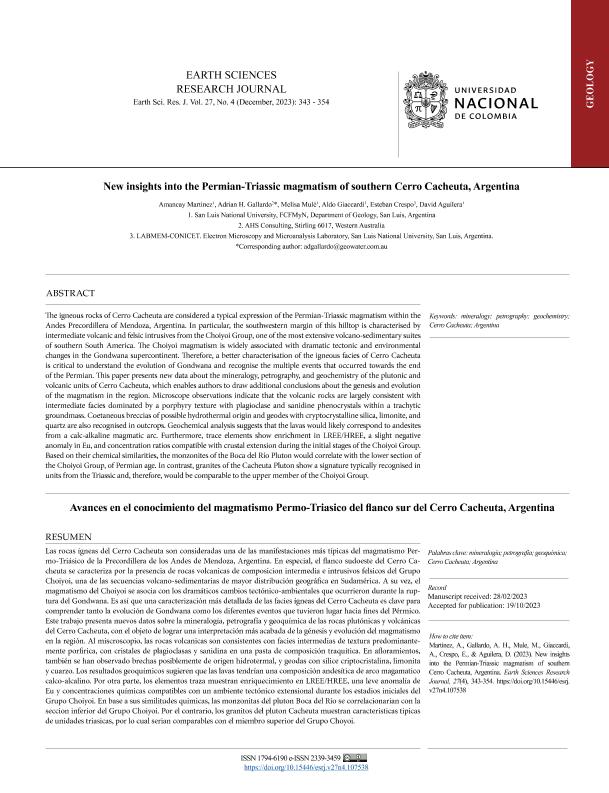Artículo
Las rocas ígneas del Cerro Cacheuta son consideradas una de las manifestaciones más típicas del magmatismo Permo-Triásico de la Precordillera de los Andes de Mendoza, Argentina. En especial, el flanco sudoeste del Cerro Cacheuta se caracteriza por la presencia de rocas volcánicas de composición intermedia e intrusivos félsicos del Grupo Choiyoi, una de las secuencias volcano-sedimentarias de mayor distribución geográfica en Sudamérica. A su vez, el magmatismo del Choiyoi se asocia con los dramáticos cambios tectónico-ambientales que ocurrieron durante la ruptura del Gondwana. Es así que una caracterización más detallada de las facies ígneas del Cerro Cacheuta es clave para comprender tanto la evolución de Gondwana como los diferentes eventos que tuvieron lugar hacia fines del Pérmico. Este trabajo presenta nuevos datos sobre la mineralogía, petrografía y geoquímica de las rocas plutónicas y volcánicas del Cerro Cacheuta, con el objeto de lograr una interpretación más acabada de la génesis y evolución del magmatismo en la región. Al miscroscopio, las rocas volcánicas son consistentes con facies intermedias de textura predominantemente porfírica, con cristales de plagioclasas y sanidina en una pasta de composición traquítica. En afloramientos, también se han observado brechas posiblemente de origen hidrotermal y geodas con sílice criptocristalina, limonita y cuarzo. Los resultados geoquímicos sugieren que las lavas tendrían una composición andesítica de arco magmático calco-alcalino. Por otra parte, los elementos traza muestran enriquecimiento en LREE/HREE, una leve anomalía de Eu y concentraciones químicas compatibles con un ambiente tectónico extensional durante los estadios iniciales del Grupo Choiyoi. En base a sus similitudes químicas, las monzonitas del plutón Boca del Río se correlacionarían con la sección inferior del Grupo Choiyoi. Por el contrario, los granitos del plutón Cacheuta muestran caracteristicas típicas de unidades triásicas, por lo cual serían comparables con el miembro superior del Grupo Choyoi. The igneous rocks of Cerro Cacheuta are considered a typical expression of the Permian-Triassic magmatism within the Andes Precordillera of Mendoza, Argentina. In particular, the southwestern margin of this hilltop is characterised by intermediate volcanic and felsic intrusives from the Choiyoi Group, one of the most extensive volcano-sedimentary suites of southern South America. The Choiyoi magmatism is widely associated with dramatic tectonic and environmental changes in the Gondwana supercontinent. Therefore, a better characterisation of the igneous facies of Cerro Cacheuta is critical to understand the evolution of Gondwana and recognise the multiple events that occurred towards the end of the Permian. This paper presents new data about the mineralogy, petrography, and geochemistry of the plutonic and volcanic units of Cerro Cacheuta, which enables authors to draw additional conclusions about the genesis and evolution of the magmatism in the region. Microscope observations indicate that the volcanic rocks are largely consistent with intermediate facies dominated by a porphyry texture with plagioclase and sanidine phenocrystals within a trachytic groundmass. Coetaneous breccias of possible hydrothermal origin and geodes with cryptocrystalline silica, limonite, and quartz are also recognised in outcrops. Geochemical analysis suggests that the lavas would likely correspond to andesites from a calc-alkaline magmatic arc. Furthermore, trace elements show enrichment in LREE/HREE, a slight negative anomaly in Eu, and concentration ratios compatible with crustal extension during the initial stages of the Choiyoi Group. Based on their chemical similarities, the monzonites of the Boca del Río Pluton would correlate with the lower section of the Choiyoi Group, of Permian age. In contrast, granites of the Cacheuta Pluton show a signature typically recognised in units from the Triassic and, therefore, would be comparable to the upper member of the Choiyoi Group.
New insights into the Permian-Triassic magmatism of southern Cerro Cacheuta, Argentina
Título:
Avances en el conocimiento del magmatismo Permo-Triasico del flanco sur del Cerro Cacheuta, Argentina
Martinez, Amancay Nancy ; Gallardo, Adrian Hugo
; Gallardo, Adrian Hugo ; Mulé, Melisa Monserrat; Giaccardi, Aldo Darío; Crespo, Esteban María
; Mulé, Melisa Monserrat; Giaccardi, Aldo Darío; Crespo, Esteban María ; Aguilera, David
; Aguilera, David
 ; Gallardo, Adrian Hugo
; Gallardo, Adrian Hugo ; Mulé, Melisa Monserrat; Giaccardi, Aldo Darío; Crespo, Esteban María
; Mulé, Melisa Monserrat; Giaccardi, Aldo Darío; Crespo, Esteban María ; Aguilera, David
; Aguilera, David
Fecha de publicación:
10/2023
Editorial:
Universidad Nacional de Colombia
Revista:
Earth Sciences Research Journal
ISSN:
1794-6190
e-ISSN:
2339-3459
Idioma:
Inglés
Tipo de recurso:
Artículo publicado
Clasificación temática:
Resumen
Palabras clave:
MINERALOGY
,
PETROGRAPHY
,
GEOCHEMISTRY
,
CERRO
,
CACHEUTA
,
ARGENTINA
Archivos asociados
Licencia
Identificadores
Colecciones
Articulos(CCT - SAN LUIS)
Articulos de CTRO.CIENTIFICO TECNOL.CONICET - SAN LUIS
Articulos de CTRO.CIENTIFICO TECNOL.CONICET - SAN LUIS
Citación
Martinez, Amancay Nancy; Gallardo, Adrian Hugo; Mulé, Melisa Monserrat; Giaccardi, Aldo Darío; Crespo, Esteban María; et al.; New insights into the Permian-Triassic magmatism of southern Cerro Cacheuta, Argentina; Universidad Nacional de Colombia; Earth Sciences Research Journal; 27; 4; 10-2023; 343-354
Compartir
Altmétricas



